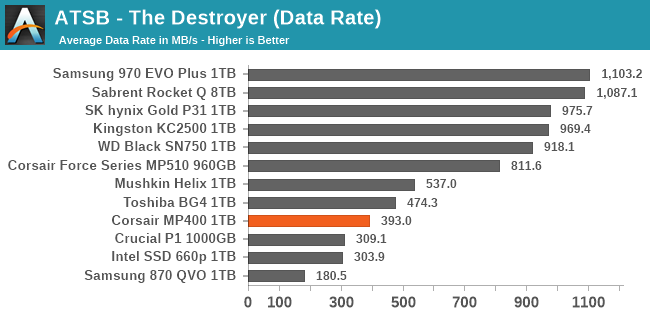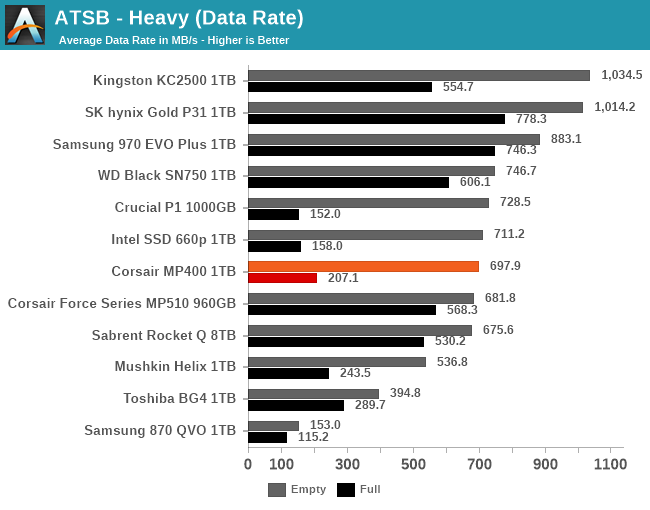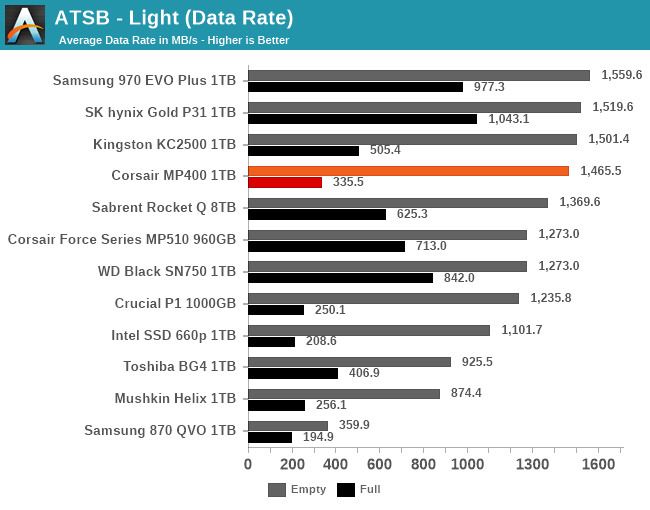The Corsair MP400 1TB QLC NVMe SSD: A Quick Review
by Billy Tallis on December 11, 2020 2:00 PM ESTAnandTech Storage Bench - The Destroyer
The Destroyer is an extremely long test replicating the access patterns of very IO-intensive desktop usage. A detailed breakdown can be found in this article. Like real-world usage, the drives do get the occasional break that allows for some background garbage collection and flushing caches, but those idle times are limited to 25ms so that it doesn't take all week to run the test. These AnandTech Storage Bench (ATSB) tests do not involve running the actual applications that generated the workloads, so the scores are relatively insensitive to changes in CPU performance and RAM from our new testbed, but the jump to a newer version of Windows and the newer storage drivers can have an impact.
We quantify performance on this test by reporting the drive's average data throughput, the average latency of the I/O operations, and the total energy used by the drive over the course of the test.
 |
|||||||||
| Average Data Rate | |||||||||
| Average Latency | Average Read Latency | Average Write Latency | |||||||
| 99th Percentile Latency | 99th Percentile Read Latency | 99th Percentile Write Latency | |||||||
| Energy Usage | |||||||||
The Corsair MP400 is faster on The Destroyer than the other 1TB QLC drives that are based on 4-channel controllers, but it's also generally slower than the DRAMless TLC drives. The MP400 and other QLC drives also require far more energy than the fairly efficient DRAMless TLC competition.
AnandTech Storage Bench - Heavy
Our Heavy storage benchmark is proportionally more write-heavy than The Destroyer, but much shorter overall. The total writes in the Heavy test aren't enough to fill the drive, so performance never drops down to steady state. This test is far more representative of a power user's day to day usage, and is heavily influenced by the drive's peak performance. The Heavy workload test details can be found here. This test is run twice, once on a freshly erased drive and once after filling the drive with sequential writes.
 |
|||||||||
| Average Data Rate | |||||||||
| Average Latency | Average Read Latency | Average Write Latency | |||||||
| 99th Percentile Latency | 99th Percentile Read Latency | 99th Percentile Write Latency | |||||||
| Energy Usage | |||||||||
On the Heavy test, the Corsair MP400 and other QLC drives offer superior peak performance compared to the DRAMless TLC drives, but that situation is reversed when the test is run on a full drive. The MP400 in particular doesn't seem to be as good as the other QLC drives at maintaining decent read latency when full, but this test is very write-intensive so the MP400's overall performance on the full-drive test run is still better than the other QLC drives.
AnandTech Storage Bench - Light
Our Light storage test has relatively more sequential accesses and lower queue depths than The Destroyer or the Heavy test, and it's by far the shortest test overall. It's based largely on applications that aren't highly dependent on storage performance, so this is a test more of application launch times and file load times. This test can be seen as the sum of all the little delays in daily usage, but with the idle times trimmed to 25ms it takes less than half an hour to run. Details of the Light test can be found here. As with the ATSB Heavy test, this test is run with the drive both freshly erased and empty, and after filling the drive with sequential writes.
 |
|||||||||
| Average Data Rate | |||||||||
| Average Latency | Average Read Latency | Average Write Latency | |||||||
| 99th Percentile Latency | 99th Percentile Read Latency | 99th Percentile Write Latency | |||||||
| Energy Usage | |||||||||
The Light test is short enough to fit entirely within the SLC cache of the 1TB Corsair MP400 when the test is run on an empty drive. That allows the MP400 to outperform the 8TB Sabrent Rocket Q, which is burdened with extra overhead of managing so much flash. The DRAMless TLC drives cannot match the peak performance of the QLC drives that have DRAM. When the test is run on a full drive, the performance of the QLC drives as usual suffers greatly, but the Corsair MP400 remains faster than at least some of the DRAMless TLC drives.










75 Comments
View All Comments
DZor - Friday, December 11, 2020 - link
Today's drives have less and less endurance.This Corsair 1TB model just 200TBW
For example Samsung 860 EVO is 600TBW!!!! Three times longer!!!
rozquilla - Friday, December 11, 2020 - link
Agree, it is an almost disposable storage device. On the other hand an average office/web user will not reach this level of writes for years, but somebody using NVMe drives in RAID for content creation will need to have like an ammo box of these drives nearby to keep swapping drives.Tomatotech - Friday, December 11, 2020 - link
Maybe, maybe this type of drive, at this price point, isn't aimed at 'content creators'. Anyone earning a living off content creating is going to be using rather more expensive tools. Looks perfectly fine for the average user.In the recent Anandtech review of the QLC 8TB nvme drive, I was really quite impressed the way the 8TB drive leveraged its vast storage space to overcome many of the QLC limitations. It was able to use up to 2TB as high speed SLC-level cache. Many people will rarely move more than 1 or 2 TB in a single operation.
Looking forward to 8TB QLC+ drives dropping to mortal prices.
danbob999 - Monday, December 14, 2020 - link
The thing is, is that drive is 7 TB full, you don't get that same 2 TB cache. There is likely at most 256 GB left.TheinsanegamerN - Tuesday, December 15, 2020 - link
And how many users are going to move 256GB at once?at_clucks - Wednesday, December 16, 2020 - link
You're asking the wrong question. What happens when you have a full drive (like most regular users end up doing because data tends to cruft up in there), and now you juggle all your operations in the little space you have free? Sure, wear leveling you might say but again, in an SSD with sub-mediocre performance AND endurance that will not go well because that's a lot of data you move around to do wear leveling. Keep in mind that wear leveling isn't about getting lower total wear but rather getting uniform wear and spread out concentration of write cycles (it actually increases wear by write amplification). Eventually the drive, depending on how its WL algorithms work, will start moving the long stationary data around to the blocks that were used more, in order to write the more dynamic data to those "pristine" blocks. *All* of that data has to be constantly shuffled for the WL to work as expected. That's how WL and garbage collection work and it's great when you have a lot of free space and basically treat it as a small drive with 7TB to spare to make up for shitty QLC.You can't get something from nothing, having a lot of space makes the issue "less obvious" to the user, not "non-existent", and only if it's free. The issue is still there. The free space kept free is the price you pay for having a working drive. Like a CPU with 32 cores but you can never use more than 12 because they will out.
Maverick009 - Friday, December 11, 2020 - link
Even content creators do not have to worry as much, plus the serious ones still use Mechanical Hard drives, but usually the NAS quality ones like the IronWolf/Pro drives due to storage space per cost still being greatly cheaper. The SSD will be mainly used for the OS and applications to launch from, with a few using an SSD as a scrub drive, or RAID several mechanical drives together and use an SSD as a cache drive between them moving data much faster, while having also having the benefits of large storage.Beaver M. - Saturday, December 12, 2020 - link
No. You need a fast SSD when editing. A HDD is only useful for archiving anymore.niva - Wednesday, December 16, 2020 - link
Seriously, did you even read his comment?Beaver M. - Friday, December 18, 2020 - link
What? Youre acting as if what he claimed is any proof.